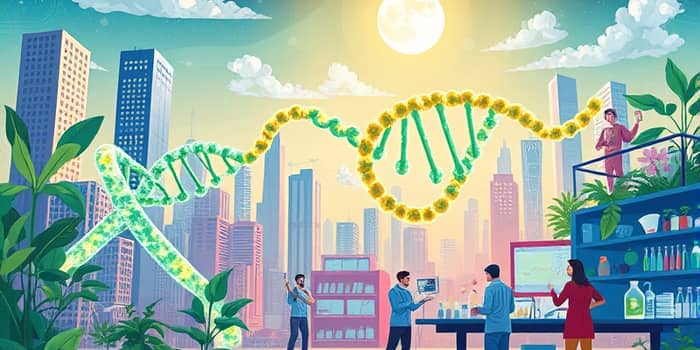
Every era brings transformative breakthroughs that reshape our collective future, and biotechnology stands at the forefront of the next industrial revolution. From unlocking the secrets of the human genome to engineering crops that thrive in extreme climates, the promise of biotech extends far beyond laboratories. As global markets surge and investment flows accelerate, we find ourselves on the cusp of an unprecedented era of growth, one that carries profound benefits for health, sustainability, and economic resilience worldwide.
The scope of this expansion is nothing short of extraordinary. Industry analysts forecast that the global biotechnology market is set to double within the next decade, potentially reaching USD 5.85 trillion by 2034 with a compound annual growth rate (CAGR) of 13.6% from 2025 onward. Alternative projections still estimate a valuation of USD 4.61 trillion over the same period, underscoring a rapidly evolving landscape. By 2025, the market size is expected to climb to more than USD 1,034.63 billion, while the pharmaceutical segment alone could eclipse USD 3 trillion by 2034.
These figures reflect not only growing commercial demand but also enduring confidence among researchers, investors, and policymakers who recognize biotechnology’s role in delivering innovative treatments and sustainable solutions across a broad array of applications.
At the heart of this expansion lies a constellation of cutting-edge technologies poised to redefine the frontiers of science and medicine. Artificial intelligence, advanced gene editing, and regenerative techniques are converging to accelerate discovery and streamline development pipelines.
With machine learning models now capable of scanning millions of molecular structures in seconds, researchers can pinpoint promising compounds with unprecedented speed. In parallel, CRISPR-based platforms and synthetic biology have reduced gene editing error rates dramatically, facilitating the design of next-generation therapeutics. Complementing these advances, 3D bioprinting and patient-specific genetic diagnostics usher in a new era of tailored medical interventions for each individual, while regenerative medicine offers hope for restoring damaged tissues and organs.
While AI accelerates molecule screening, integrating big data from genomics, proteomics, and phenomics creates a foundation for truly holistic drug discovery. Companies are deploying real-world evidence gleaned from electronic health records to refine trial designs, minimize risk, and optimize patient outcomes. Additionally, advances in nanobiotechnology are enabling targeted drug delivery systems that reduce side effects and improve therapeutic potency.
Behind these breakthroughs stands a robust ecosystem of more than 107,000 companies and over 5,800 startups, each vying to translate scientific potential into marketable solutions. Investment rounds are becoming larger and more strategic, with the average financing event valued at around USD 47.7 million. Major players such as Bayer, Arch Venture Partners, and OrbiMed have emerged as leading backers, channeling capital toward visionary projects.
Yet, the rapid pace of advancement is tempered by financial realities. Only about 40% of publicly listed biotechnology firms in the United States possess enough cash to sustain operations through 2025, prompting a strategic pivot toward leaner pipelines and more focused research goals. This rigorous discipline is fostering a new generation of companies that prioritize viability alongside innovation.
As capital becomes more discerning, successful enterprises will be those that balance bold vision with prudent financial stewardship and efficient resource management, ensuring they can weather market fluctuations and regulatory shifts.
Governments and philanthropic organizations are also amplifying support through grants and public-private partnerships. In key markets, policy incentives reduce barriers to commercialization, while tax credits and research subsidies spur collaboration between startups and academic centers. This layered funding ecosystem ensures that high-risk, high-reward projects have multiple pathways to secure resources, reinforcing a resilient funding landscape for biotech pioneers.
Biotechnology’s expansion is not solely a story of molecules and machines; it is also a narrative of people. Today’s sector employs approximately 13.2 million professionals worldwide, spanning roles in research and development, production, regulatory affairs, and beyond. Over the past year alone, an estimated 740,000 new jobs were created, reflecting surging demand for skilled workers.
Universities, training institutes, and industry consortia are stepping up efforts to bridge talent gaps, offering accelerated programs in bioinformatics, molecular biology, and regulatory science. Mentorship, cross-disciplinary collaboration, and hands-on apprenticeships are becoming pillars of workforce development, equipping the next generation with the tools needed to drive discovery and commercialization.
The sector’s evolution demands not only technical expertise but also skills in regulatory strategy, ethics, and business development. Cross-disciplinary teams that blend scientific acumen with commercial insight are increasingly valued. Mentorship programs, diversity initiatives, and remote learning platforms are broadening access to educational resources, empowering individuals from varied backgrounds to contribute to biotech’s future breakthroughs.
From coast to coast and across continents, certain regions have crystallized into vibrant hubs where academia, industry, and government converge. The United States remains a powerhouse, with landmark clusters in Boston, San Francisco, San Diego, and New York. Meanwhile, Europe features flourishing ecosystems in London and Berlin, and Asia boasts dynamic centers in China and India.
These geographical networks represent complex webs of collaboration and opportunity where ideas cross-pollinate and breakthroughs accelerate. Strategic alliances between hubs are dissolving barriers, enabling startups in emerging markets to access capital, expertise, and global distribution channels.
Incubators and accelerators play a pivotal role in nurturing early-stage ventures, offering access to shared lab facilities, mentorship networks, and investor introductions. International collaborations, such as joint research consortia across Europe and Asia, exemplify how scientific diplomacy can transcend borders, fostering breakthroughs that might otherwise remain siloed. These collaborative models are redefining how we conceive global innovation networks, ensuring that emerging markets can leapfrog traditional development pathways.
Despite its promise, the biotechnology industry faces formidable challenges. Regulatory frameworks must evolve to keep pace with novel therapies, ensuring safety while fostering innovation. Financial pressures demand companies adopt leaner operations without stifling creativity. Public perception and ethical considerations around gene editing and synthetic biology require transparent dialogue and responsible stewardship.
Supply chain disruptions, such as shortages of critical reagents and bioprocessing materials, have underscored the need for more localized manufacturing capacity and diversified sourcing strategies. Cybersecurity threats targeting proprietary data and research pipelines raise concerns about intellectual property protection. Addressing these issues will require robust digital defenses and strategic planning to ensure the uninterrupted advance of vital research efforts.
Yet every challenge presents an opportunity. Streamlined regulatory pathways can reduce time-to-market for life-saving treatments, adaptive funding models can empower more diverse portfolios, and inclusive stakeholder engagement can build public trust. Investments in biosecurity and sustainable practices will drive resilience, safeguarding both economic interests and global health.
As we gaze toward the horizon, the trajectory of biotechnology offers compelling reasons for optimism. Breakthroughs in personalized medicine, sustainable agriculture, and environmental remediation promise to address some of humanity’s most pressing challenges. Collaborative research initiatives spanning continents will accelerate knowledge transfer and democratize access to cutting-edge technologies.
Crucially, success will hinge on a collective commitment to responsible innovation. By cultivating talent, aligning incentives, and fostering transparent partnerships between public and private sectors, we can ensure that the benefits of biotech are widely shared. In doing so, we unlock not only economic growth but also the potential for healthier lives, more resilient ecosystems, and a sustainable future for generations to come.
The stage is set for a golden age of biotechnology. Stakeholders across academia, industry, and government have a pivotal role to play. Together, we can transform bold aspirations into tangible realities, driving long-term growth and positive societal impact that resonate far beyond the laboratory walls.
References













